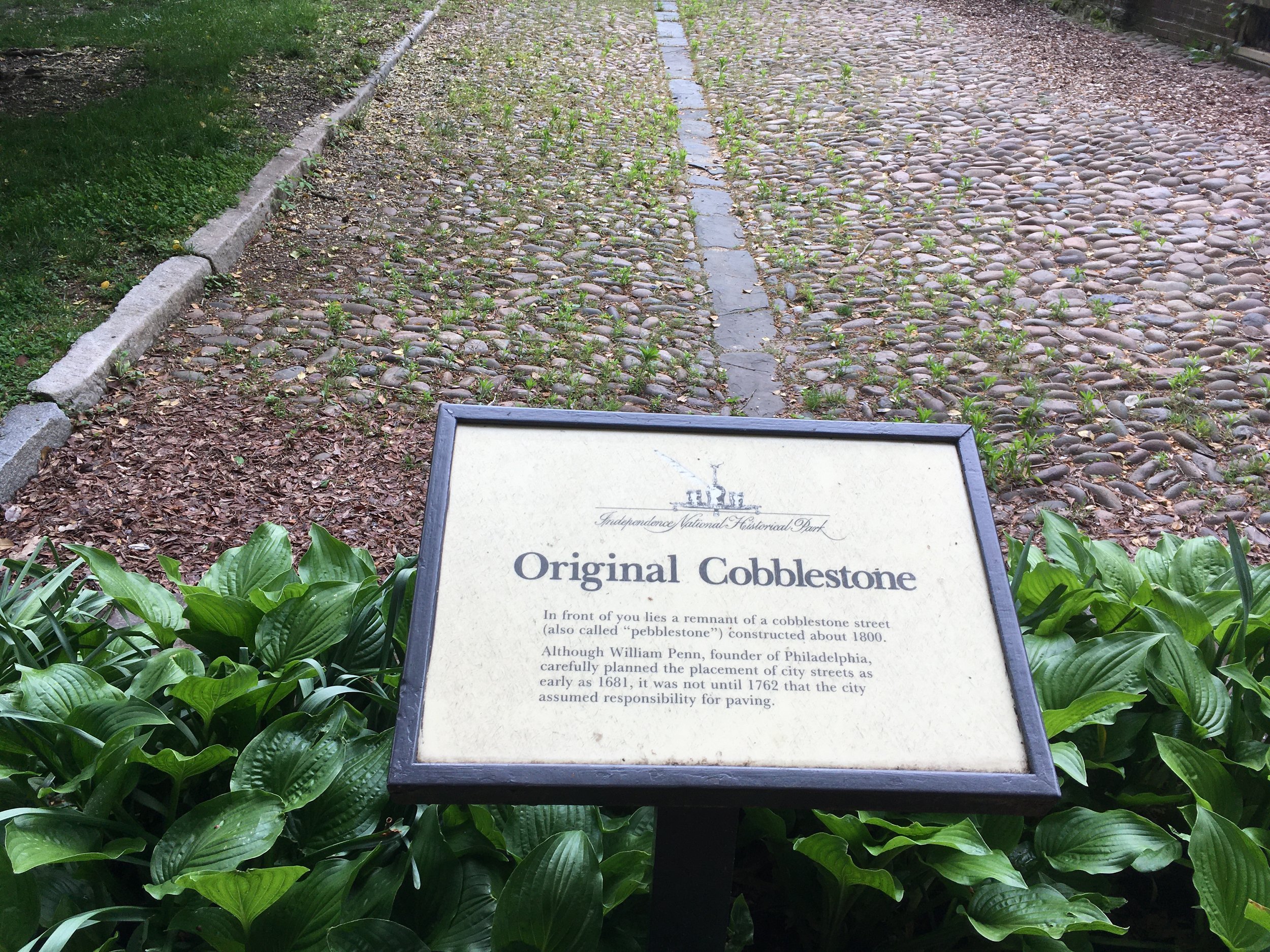Road Work
Is this Philly street made of cobblestones or Belgian Block?
These are rounded stones, probably from a riverbed. So they’re cobblestones. Photo by Jim Murphy, author of “Real Philly History, Real Fast.”
What I’ve learned in 15 years of researching Philly history is this: If round, it’s cobblestone. If rectangular, it’s Belgian Block!
But while researching this blog, I came across numerous answers I think are completely wrong … including one in a New York Times photo caption from July 18, 2010, misidentifying what are clearly Belgian Block as cobblestones. And I don’t understand why this misinformation is occurring.
Exhibit A: Oxford Languages defines cobblestone as: “A small, round stone of a kind formerly used to cover road surfaces.” Another site, Sepulveda Building Materials, says: River Cobbles are rounded and smoothed stones found in river or creek beds. Cobbles range in size from 4" to 8" inches up to 12" to 18" inches in diameter.
Historically, the word cobblestone comes from blending two words, cob and stone. In fact, the word cob in Old English meant a “rounded lump,” says HistoricEuropeanCobblestone.com. So why the confusion?
Exhibit B: This Independence National Historical Park marker — between 4th and 5th Street south of Walnut Street in the Rose Garden — labeled Original Cobblestone — says:
“In front of you lies a remnant of a cobblestone street (also called “pebblestone”) constructed about 1800. Although William Penn, founder of Philadelphia carefully planned the placement of city streets as early as 1681, it was not until 1762 that the city assumed responsibility for paving.
As you can see, these cobblestones are definitely rounded, no matter what the New York Times now says. Photo by Jim Murphy.
So let’s ignore the New York Times folly for the moment.
Belgian Block: Is usually rectangular and made of granite, although today it can be limestone or sandstone, too. The name reportedly comes from large stones used as ballast on ships coming to North America from Flanders, Antwerp or the Netherlands in the 17th and 18th centuries. In 2023, it has no affiliation with Belgium; but, the name continues to be used.
Cobblestone came first
A Philadelphia road report from 1998 indicates how road paving here changed over the years. By 1884, cobblestone made up 93% of the pavement in the city, which had some 535 miles of paved streets.
However, by 1916, only 0.3% of Philly streets were cobblestone; the rest consisted of “several varieties of improved materials.” These included Belgian Block and later gravel; eventually, city officials called asphalt “the pavement that comes nearest to the ideal pavement for a large city for either light or heavy traffic.”
This Belgian Block, usually rectangular and probably granite, is used on 5th Street between Walnut and Chestnut Streets. Photo by Jim Murphy.
For a short time, wood paving was used near schools and hospitals to reduce noise. But horse urine rotted it, and by 1919 the city began removing the 20 miles of wood block paving that still existed.
Philadelphia did keep wood pavers on little Camac Street for almost 100 years, though. After a major reconstruction in 2012, however, the new pavers began to rot and pop out. Inquirer architecture critic Inga Saffron reported in December 2015 that the city was due to replace them in 2016. I don’t believe that ever happened.
When I inspected the 200 block of Camac Street on June 19, 2023, no wood pavers were in sight.
Historic paving in Philly
As one of the nation’s oldest cities, Philadelphia continues to use historic paving materials on some of its roads. In its 1998 report, the city said this included 328 blocks on 159 different streets.
Granite block that varied greatly in color and shape from street to street was on 68% of the streets; Of those, nine were paved with “Belgian Blues” — uniform and rectangular granite blocks glazed in blue to look like brick. Red brick was the choice on 25% of the total number of blocks. Yellow and orange brick was used on 11 other blocks.
Good progress
In 1905, Good Roads Magazine called Philadelphia “the best paved city in the Union, with proportionately a greater percentage of improved pavements than any other city, and twenty-one percent (21%) more than greater New York.”
Interesting Oddities:
North 2nd Street from Market (originally High Street) to Vine Street may be the first municipally paved street in the city, says the 1998 report. It quotes “Watson’s Annals” and the “1762 Minutes of the Assembly of Pennsylvania” as authorizing a lottery to raise $7,500 for this paving.
Bicyclists don’t seem to be big fans of Belgian Block, because it can easily cause a fall. A city bicycle and pedestrian plan of 2012 suggests “integrating a narrow section of bricks or smoother blocks” into Dock Street between 2nd and Spruce Streets” to make these historic street segments safer for bike riders.
On November 12,1984, a brazen crook tried to steal all the Belgian Block on the 100 block of East Mifflin Street, says the Philadelphia Inquirer’s Tommy Rowan. An excavator from Montgomery County ripped up 16,300 pavers before a shopkeeper called the city to question the work. In 2016, the estimated worth of that block was about $150,000.
Some Sources:
https://en.wikipedia.org/wiki/Cobblestone
https://hiddencityphila.org/2011/08/belgian-blocks-revealed-overnight/
https://www.bobvila.com/articles/the-history-of-cobblestones/
https://www.elfrethsalley.org/blog/2021/9/16/the-street-beneath-our-feet
https://www.historiceuropeancobblestone.com/belgian-block-or-belgium-block-what-are-they/
https://www.historiceuropeancobblestone.com/what-is-belgium-block/
https://www.inquirer.com/news/septa-belgian-block-history-preservation-safety-20220712.html
https://www.inquirer.com/transportation/camac-street-philadelphia-wood-blocks-history-20200204.html
https://www.nytimes.com/2010/07/19/nyregion/19cobblestone.html
https://www.phila.gov/media/20190213131359/Thematic-District-Street-Paving.pdf
https://untappedcities.com/2017/09/01/10-fun-facts-about-nyc-belgian-block-not-cobblestone-streets
https://whyy.org/articles/look-down-historic-street-paving-thematic-district/
Here are both surfaces in one photo. At the top is Belgium Block. Closest to you at the bottom are cobblestones. Photo by Jim Murphy.



